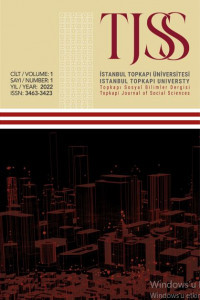Exploring Urban Poverty in Bangladesh: Dynamics, Coping Strategies and Beyond
kentsel yoksulluk, kentsel yoksullar, başa çıkma stratejisi, Dakka, Bangladeş
Exploring Urban Poverty in Bangladesh: Dynamics, Coping Strategies and Beyond
urban poverty, urban poor, coping strategy, Dhaka, Bangladesh,
___
- Asian Development Bank (ADB).(2014). Urban Poverty In Asia. Manila: Asian Development Bank.
- Asia-Pacific Economic Cooperation (APEC). (2022). Policy Brief. APEC Policy Support Unit, POLICY BRIEF No. 43. N.P.
- Baker, J.L.(2008). Urban Poverty: A Global View. The World Bank Group Urban Papers (UP-5). Washington DC: The World Bank.
- Baker, J.L. (ed.)(2012). Climate Change, Disaster Risk, and the Urban Poor: Cities Building Resilience for a Changing World.Washington DC: The World Bank.
- Bangladesh Bureau of Statistics (BBS). (2015). Census of Slum Areas and Floating Population 2014. Dhaka: Statistics and Informatics Division (SID), Ministry of Planning,Government of the People’s Republic of Bangladesh.
- Bangladesh National Portal. Divisions. https://bangladesh.gov.bd/site/view/division-list/%E0%A6%AC%E0%A6%BF%E0%A6%AD%E0%A6%BE%E0%A6%97%E0%A6%B8%E0%A6%AE%E0%A7%82%E0%A6%B9 accessed22 September 2022.
- Bangladesh Rural Advancement Committee (BRAC). (n.d). WASH-Factsheet. Water, Sanitation And Hygiene, Urban Development Programme. http://www.brac.net/program/wp-content/uploads/2020/02/WASH-FACTSHEET.pdf accessed 25 September 2022.
- Banks, N. (2012)Urban poverty in Bangladesh: consequences, and coping Strategies. BWPI Working Paper 178. Manchester: Brooks World Poverty Institute, University of Manchester, UK.
- Bhattacherjee, A. (2012). Social Science Research: Principles, Methods, and Practices. Textbooks Collection. 3. http://scholarcommons.usf.edu/oa_textbooks/3
- Britannica, T. Editors of Encyclopaedia (2019, September 25). Strain theory. Encyclopedia Britannica. https://www.britannica.com/topic/strain-theory-sociology
- Britannica, T. Editors of Encyclopaedia (2022, June 12). Alienation. Encyclopedia Britannica. https://www.britannica.com/topic/alienation-society
- D'lima, T., and Grabinsky, J. (2022). COVID outbreaks took heavy mental health toll on the urban poor. Published on End Poverty in South Asia, The World bank Blogs.https://blogs.worldbank.org/endpovertyinsouthasia/covid-outbreaks-bangladesh-take-heavy-mental-health-toll-urban-poor accessed 25 September 2022.
- Fish, O. (2020). Socialization and Poverty: How Social Protection Uplifts Communities. The Borgen Project Blog. https://borgenproject.org/socialization-and-poverty/#:~:text=Socialization%20and%20poverty%20is%20a,same%20activities%20as%20their%20peers. accessed 23 September 2022
- Garber, J. (2017). There's a new 'Asian Tiger'. An article published in the Business Insider on April 7 2017. https://www.businessinsider.com/bangladesh-is-the-new-asian-tiger-2017-4 accessed16 September 2022.
- Holcomb-McCoy, C. (2004). Alienation: a concept for understanding low-income, urban clients. Journal of Humanistic Counseling, Education and Development, 43(2), 188+. https://link.gale.com/apps/doc/A125956049/AONE?u=anon~955e228b&sid=googleScholar&xid=acef5589
- Hossain, Z.R. et al. (2022). Recovery with distress: unpacking COVID-19 impact on livelihoods and poverty in Bangladesh. WIDER Working Paper 2022/13. Helsinki: United Nations University World Institute for Development Economics Research.
- International Monetary Fund. IMF Country Focus - Bangladesh Prepares for a Changing Climate. https://www.imf.org/en/News/Articles/2019/09/18/na09182019-bangladesh-prepares-for-a-changing-climate accessed16 September 2022.
- Khondoker, Z.A. (2020). The State of Education in Urban Slums of Bangladesh. BRAC Institute of Governance and Development, BRAC University. https://bigd.bracu.ac.bd/the-state-of-education-in-urban-slums-of-bangladesh/ accessed 25 September 2022.
- Kim, O.M. (2019). The health challenges for the urban poor. An article published in The Daily Star on March 30, 2019. https://www.thedailystar.net/opinion/perspective/news/the-health-challenges-the-urban-poor-1722178 accessed 25 September 2022.
- Lipu, M.S.H., Jamal, T., and Miah, M.A.R. (2013). Barriers to Energy Access in the Urban Poor Areas of Dhaka, Bangladesh: Analysis of Present Situation and Recommendations. International Journal of Energy Economics and Policy Vol. 3, No. 4, 2013, pp.395-411
- Local Government Division. Organizations. http://www.lgd.gov.bd/ accessed16 September 2022.
- Malik, A. (2019). Children in slums: Living in inhumane conditions. An article published in The Daily Star on November 20, 2019.https://www.thedailystar.net/supplements/news/children-slums-living-inhumane-conditions-1829566 accessed 25 September 2022.
- Sarin, A., and Jain, R. (2009). Effect of Mobiles on Socio-economic Life of Urban Poor. Ahmedabad: Indian Institute of Management (IIM).
- Şengönül, T. (2021). The Adverse Role of Poverty in the Socialization Processes in the Family and in the Cognitive Development of Children and School Performance. Journal of Education and Instruction, Vol. 11, No. 2, 2021, 1-13. DOI: 10.14527/pegegog.2021.00
- Šerić, M. (2022). Bangladesh: A New Asian Tiger On The Horizon. An Op-Ed published in Eurasia Review. https://www.eurasiareview.com/06092022-bangladesh-a-new-asian-tiger-on-the-horizon-oped/ accessed16 September 2022.
- Shildrick,T., and Rucell, J. (2015). Sociological perspectives on poverty.Joseph Rowntree Foundation. https://www.jrf.org.uk/report/sociological-perspectives-poverty accessed 25 September 2022.
- Spencer-Wood, S. M., and Matthews, C. N. (2011). Impoverishment, Criminalization, and the Culture of Poverty.Historical Archaeology, 45(3), 1–10. http://www.jstor.org/stable/23070030
- The Centre for Urban Design and Mental Health.How The City Affects Mental Health. https://www.urbandesignmentalhealth.com/how-the-city-affects-mental-health.html#:~:text=Cities%20are%20associated%20with%20higher,click%20here%20for%20more%20detail). accessed 25 September 2022.
- The World Bank. Urban Development. https://www.worldbank.org/en/topic/urbandevelopment/overview accessed 16 September 2022.
- The World Bank Data. GDP growth (annual %) - Bangladesh. https://data.worldbank.org/indicator/NY.GDP.MKTP.KD.ZG?locations=BD accessed 16 September 2022.
- The World Bank. Fact Sheet: An Adjustment to Global Poverty Lines. https://www.worldbank.org/en/news/factsheet/2022/05/02/fact-sheet-an-adjustment-to-global-poverty-lines#:~:text=As%20differences%20in%20price%20levels,%242.15%20per%20person%20per%20day. accessed 25 September 2022.
- United Nations Children's Fund (UNICEF) Bangladesh. Children in cities. https://www.unicef.org/bangladesh/en/children-cities%C2%A0 accessed 25 September 2022.
- United Nations Department of Economic and Social Affairs. News: 68% of the world population projected to live in urban areas by 2050, says UN.https://www.un.org/development/desa/en/news/population/2018-revision-of-world-urbanization-prospects.html accessed 16 September 2022.
- United Nations Development Programme. (2022). Human Development Report 2021-2022: Uncertain times, unsettled lives - Shaping our future in a transforming world. New York: United Nations Development Programme (UNDP).
- United Nations Development Programme (UNDP) Bangladesh. Housing solutions for the urban poor in Bangladesh. https://www.undp.org/bangladesh/press-releases/housing-solutions-urban-poor-bangladesh accessed 25 September 2022.
- United Nations Population Facts. (2020).Department of Economic and Social Affairs, United Nations. N.P.
- WaterAid Bangladesh. Urban WASH programme.https://www.wateraid.org/bd/urban-wash-programme accessed 25 September 2022.
- World Health Organization.Bangladesh Situation.https://covid19.who.int/region/searo/country/bd accessed 16 September 2022.
- ISSN: 2822-3853
- Başlangıç: 2022
- Yayıncı: İstanbul Topkapı Üniversitesi
Türk Hukukunda yoksulluğa karşı nafaka yükümlülükleri, uygulama sorunları ve çözüm önerileri
Almanya ve Türkiye'de Yaşayan Evsizlerin Kültürel Deneyimleri
Helin Hazal ÇAKMAK, Gökhan GÖKGÖZ
Tuğba BAYDENİZ, Vesile KÜÇÜK, Hüseyin GÖKAL
Gösterişe Yönelik Tüketim Kavramının İncelenmesi
Bong Joon Ho’nun Parazit Filminde Kent Yoksulluğu İmgeleri
Finding Neverland: Homelessness and Despair in the Urban Space
A POLITICAL ECONOMY OF INADEQUATE HOUSING IN KENYA: A CASE OF MATHARE VALLEY, NAIROBI
Exploring Urban Poverty in Bangladesh: Dynamics, Coping Strategies and Beyond
Poverty and Local Equality Plans: An Analysis of İstanbul, İzmir, and Ankara
Itır BAGDADİ, Işıl KELLEVEZİR, Huriye TOKER
Türkiye’de Artan Konut İhtiyacı ve Konut Sorununun Dinamikleri
